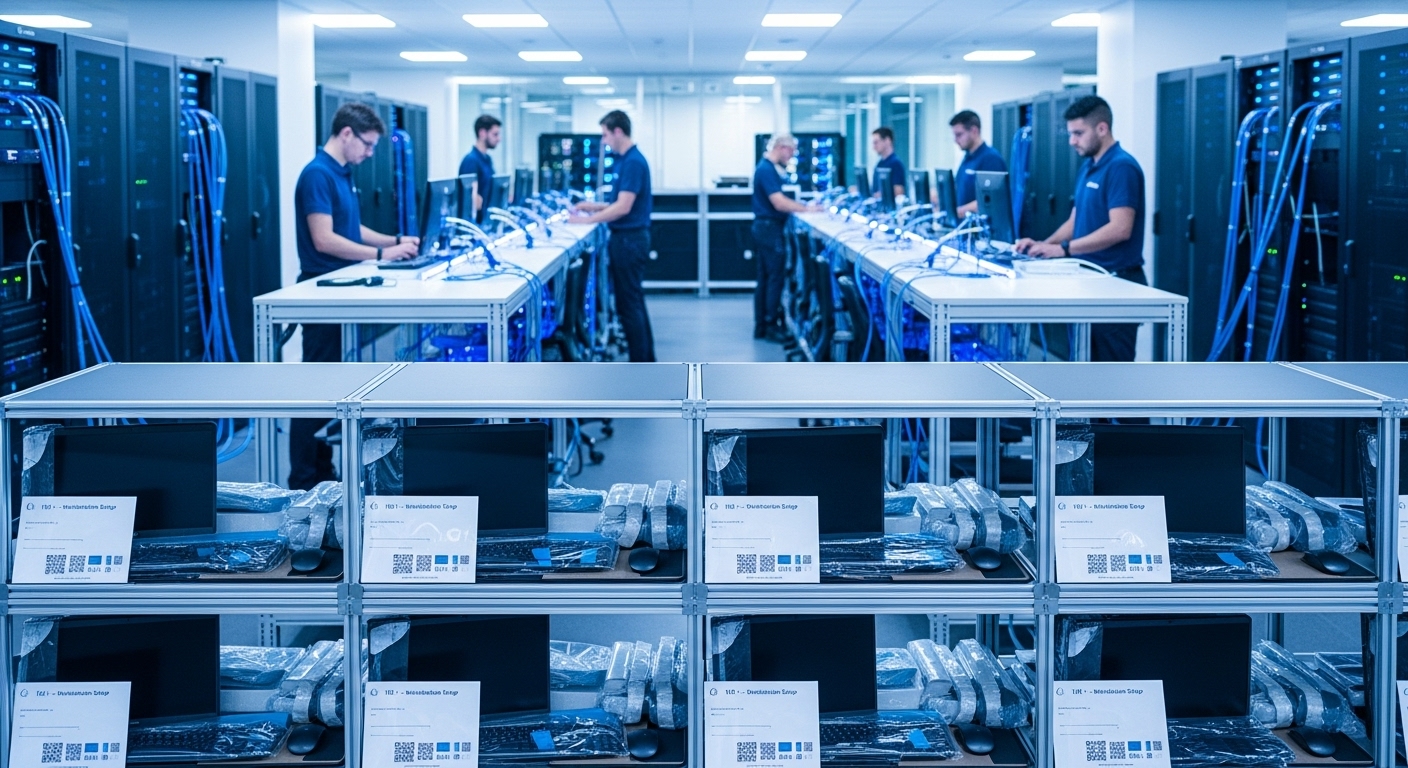Setting up a new office is a monumental task, but at its core lies a challenge that defines modern business resilience: the IT setup. This isn’t just about plugging in computers; it’s about architecting the digital nervous system of your entire operation. In a thriving commercial hub, a flawless IT infrastructure is not a luxury, it’s a foundational requirement for growth, security, and competitive advantage. A poorly planned setup can lead to crippling downtime, security vulnerabilities, and operational bottlenecks that stifle progress before it even begins. Conversely, a strategic, well-executed IT deployment becomes a powerful business enabler, fostering productivity and scalability from day one. This definitive guide will walk you through the entire process, from laying the physical foundation of your network to erecting a robust digital firewall, ensuring your new office is not just connected, but also fortified for the future.
The Strategic Blueprint: Pre-Planning Your IT Infrastructure
Before a single cable is run or a server is ordered, the most critical phase of your IT setup begins: strategic planning. This blueprinting stage is where you translate business goals into technical requirements. Start with a comprehensive needs assessment. Who are your users? What applications will they need? What are your data storage and access requirements? Consider your growth trajectory for the next three to five years. Designing an infrastructure for 50 employees when you plan to hire 100 within two years is a recipe for a costly overhaul. Create a detailed budget that accounts for hardware, software licensing, labor, and a contingency fund for unexpected issues. This is also the time to audit your existing assets. Determine what hardware can be migrated, what needs to be upgraded, and what must be decommissioned. Finally, develop a master project plan with a clear timeline, key milestones, and assigned responsibilities. This document will be your guiding star throughout the process, preventing scope creep and ensuring all stakeholders are aligned. A common mistake is to rush this phase, but the time invested here will pay immense dividends in efficiency and cost savings down the line.
Architecting Your Digital Backbone: Network and Cabling
Your company’s network is the circulatory system of your digital operations, and its backbone is the physical cabling. Skimping here can lead to persistent performance issues that are difficult and expensive to diagnose and fix later. The standard for modern offices is structured cabling, typically using Category 6 (Cat6) or Category 6a (Cat6a) cables, which support high-speed data transfer and Power over Ethernet (PoE) for devices like VoIP phones and security cameras. Plan your data port locations meticulously, considering office layout, desk placement, conference rooms, and common areas. A well-designed Wi-Fi network is equally crucial. It’s no longer enough to place a single router in the middle of the office. A proper wireless site survey is needed to identify potential interference and determine the optimal number and placement of access points (APs) to ensure consistent, high-speed coverage everywhere. When selecting an Internet Service Provider (ISP), businesses in Burnaby are well-positioned, with access to a robust fiber-optic infrastructure that provides the high-speed, reliable connectivity essential for cloud applications and large data transfers. Choose your plan based not just on advertised speed, but on service level agreements (SLAs) that guarantee uptime.
The Command Center: Server Room Design vs. Cloud Migration
One of the most significant decisions in any modern IT setup is where your data and applications will live. The traditional approach is an on-premise server room—a dedicated, secure, and climate-controlled space housing your physical servers and networking equipment. If you choose this path, proper design is paramount. This includes dedicated power circuits, an uninterruptible power supply (UPS), adequate cooling (HVAC) to prevent overheating, and physical security measures like keycard access. However, the paradigm is shifting rapidly towards cloud computing. Migrating to a cloud provider like AWS, Azure, or Google Cloud can eliminate the need for a physical server room, reducing capital expenditure on hardware and ongoing maintenance costs. A cloud-based infrastructure offers superior scalability, accessibility, and often, built-in disaster recovery. Many businesses opt for a hybrid approach, keeping some critical services on-premise while leveraging the cloud for others. The right choice depends on your specific needs regarding security, compliance, performance, and budget. Evaluate the total cost of ownership for each option, not just the upfront investment, to make an informed, strategic decision.
The Procurement Playbook: Sourcing Hardware and Software
With your blueprint in hand, it’s time to acquire the tools of the trade. The procurement process is more than just shopping; it’s about building a standardized, manageable, and secure technology stack. For hardware like desktops, laptops, and monitors, standardization is key. Sourcing from a single vendor or a limited range of models simplifies deployment, maintenance, and support. Consider a three-to-four-year refresh cycle to avoid the pitfalls of aging equipment. When it comes to networking gear like switches, routers, and firewalls, investing in business-grade equipment from reputable brands is non-negotiable. Consumer-grade hardware lacks the performance, security features, and reliability required for a business environment. For software, conduct a thorough audit of your licensing needs. Moving to subscription-based models like Microsoft 365 or Google Workspace can provide flexibility and ensure you always have the latest versions. Centralized software deployment and license management tools are essential for maintaining compliance and security. Don’t forget to establish strong relationships with reliable vendors and resellers who can offer competitive pricing, expert advice, and logistical support during the procurement and delivery phases.
The Zero-Downtime Deployment: Execution and Migration
This is where the plan becomes reality. A smooth deployment is the ultimate goal, minimizing disruption to business operations. If you are relocating an existing office, the key is a phased migration. Never attempt to move everything at once over a single weekend. Start by setting up the core network infrastructure at the new location weeks in advance. Test every cable, port, and Wi-Fi connection rigorously. The next phase is data migration. This is a delicate process that should be planned with redundancy in mind. Perform a full backup before you begin. The actual move should be scheduled during a low-impact period, such as a weekend or holiday. Clearly label every piece of equipment, from servers to individual workstations, to ensure it ends up in the correct place. A detailed checklist for the go-live day is essential. This includes testing everything: internet connectivity, server access, application functionality, printing, and phone systems. Have your IT team or a managed service provider on-site to troubleshoot the inevitable minor issues that will arise. The goal is not a problem-free deployment, but a well-managed one where issues are identified and resolved swiftly, allowing your team to walk in and be productive from minute one.
Building the Digital Fortress: Security from Day One
In today’s threat landscape, security cannot be an afterthought; it must be woven into the fabric of your IT infrastructure from its inception. This is the ‘firewall’ aspect of your setup. Your first line of defense is a next-generation firewall (NGFW) that provides not just access control but also threat prevention, intrusion detection, and content filtering. Segment your network using VLANs to isolate different types of traffic—for instance, keeping guest Wi-Fi completely separate from your internal corporate network. Endpoint security is equally critical. Every device, from servers to laptops to mobile phones, must have robust, centrally managed antivirus and anti-malware protection. Implement a strong access control policy based on the principle of least privilege, ensuring employees only have access to the data and systems they absolutely need to perform their jobs. A comprehensive data backup and disaster recovery plan is non-negotiable. Regular, automated backups that are tested periodically are your safety net against hardware failure, cyberattacks, or natural disasters. For any business setting up shop in a major economic hub like Burnaby, establishing this digital fortress is paramount to protecting valuable company data and maintaining client trust from the very beginning.
Smart Office Integration: Future-Proofing Your Workspace
A truly modern IT setup extends beyond core networking and servers to create an intelligent, responsive, and productive work environment. This is where you future-proof your investment. Smart office technology, once a novelty, is now a key differentiator in attracting and retaining top talent. Consider integrating smart lighting and climate control systems that not only reduce energy costs but also improve employee comfort. Automated conference rooms equipped with one-touch video conferencing, wireless presentation systems, and smart scheduling can eliminate friction and make collaboration seamless. Modern access control systems can move beyond simple key fobs to mobile-based or biometric solutions, enhancing security while providing valuable data on office usage patterns. Even smaller details, like smart power strips that can be managed remotely, contribute to a more efficient and resilient operation. The key is to build a cohesive ecosystem rather than a collection of standalone gadgets. Ensure the technologies you choose can be integrated and managed from a central platform. This holistic approach to smart technology transforms your physical workspace into a strategic asset that actively supports your team’s performance and well-being.
In conclusion, executing a flawless IT setup is a complex but achievable goal. It requires a strategic shift in thinking—viewing IT not as a cost center, but as a critical investment in your business’s operational integrity and future growth. The journey from foundation to firewall is a methodical process that begins with a detailed strategic blueprint and meticulous planning. It involves architecting a robust digital backbone with high-quality cabling and network design, making a critical choice between on-premise and cloud infrastructure, and executing a smart procurement strategy. The deployment itself must be a carefully orchestrated, zero-downtime event, followed immediately by the implementation of a multi-layered security fortress. Finally, by integrating smart office technologies, you can transform your workspace into a future-proof, high-performance environment. For businesses aiming to establish a strong presence and thrive within the competitive landscape of Burnaby, this comprehensive approach is not just best practice—it’s the essential groundwork for sustained success. Getting your IT setup right from day one provides the stable, secure, and scalable platform upon which your company can build its future.





